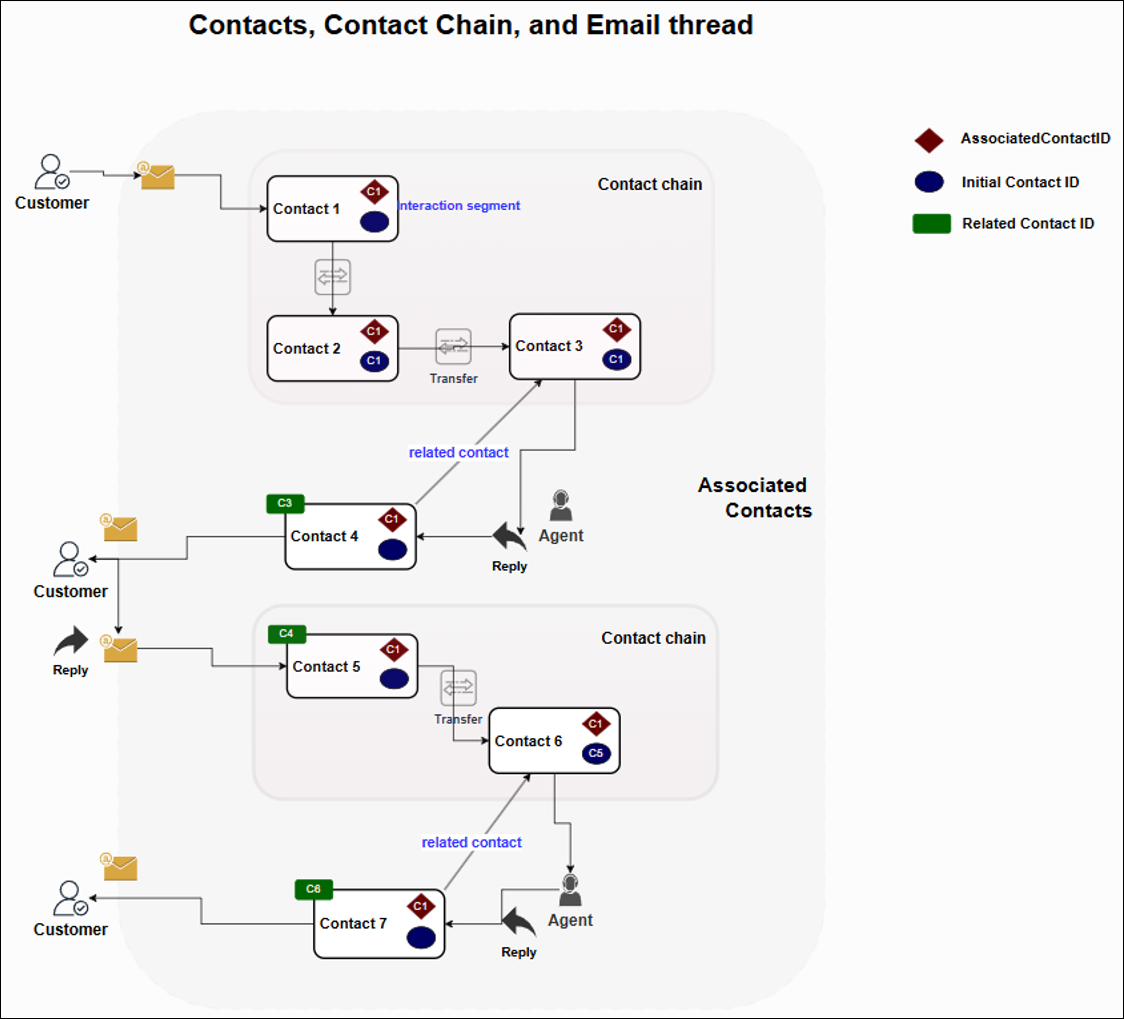Contacts, contact chains, and contact attributes
This topic explains how Amazon Connect organizes and tracks customer interactions while maintaining relevant contextual information throughout the customer journey.
Contacts
In Amazon Connect a contact represents either a segment of customer interaction, or it represents an agent's designated task.
Contact chains
As a customer interaction proceeds through the Amazon Connect infrastructure, it is represented by a contact chain. A contact chain encompasses the complete pathway from initial engagement to final resolution. This journey is orchestrated by a flow, a sophisticated routing mechanism that governs both the directional flow of calls, chats, or emails, and the methodology of handling interactions, whether through human agents or automated systems.
For example, consider the following voice interaction scenario: A customer call transfers from an initial agent to a secondary agent, and then subsequently requires escalation to a subject matter expert. This scenario creates three distinct contacts within a single interaction chain. Each participant's involvement constitutes an individual contact segment.
Similarly, in email communications, multiple exchanges between customers and business representatives form comprehensive email threads. Within these threads, each incoming correspondence has the potential to generate its own contact chain, particularly when routing occurs across multiple queues or agent transfers.
The following image illustrates the hierarchical relationship among initial contact ID, related contact ID, and associated contact ID within the Amazon Connect contact management framework. This hierarchical relationship enables you to trace and analyze the complete lifecycle of customer interactions.

Contact attributes
There are two types of contact attributes: system-defined attributes and user-defined attributes.
System-defined attributes
Amazon Connect defines attribute names (such as channel), and manages attribute values (such as voice and chat). You can create personalized customer experiences in your contact center by leveraging these system-defined contact attributes.
For example, you can customize welcome messages based on the customer's communication channel, for example, whether they're connecting through phone or chat. Essential system-defined attributes include customer endpoints (phone numbers or email addresses), agent names, communication channels (voice or chat), and more. These system-defined attributes enable you to build effective decision-making for processing customer interactions.
User-defined attributes
You can capture specific contextual information for your business through user-defined attributes. These attributes encompass details such as line-of-business names, customer account types, and contact drivers. Amazon Connect offers two types of user-defined attributes:
-
Contact attributes: These allow you to attach your own business attributes (key-value pairs) to a specific contact ID.
Use contact attributes in use cases that require consistent information sharing across interaction segments during transfers and conferences. For example, when a third agent discovers customer account information during a transfer scenario, storing it as contact attributes on the third agent's contact records would automatically reflect back to the first and second agents' contact records.
Important things to know about contact attributes:
-
For transfers and conference scenarios, the attributes and values are immediately propagated to all interaction segments within the contact chain.
-
When you update an attribute's value for a specific interaction segment, Amazon Connect automatically applies this change across all interaction segments in the contact chain.
For more information, see How contact attributes work in Amazon Connect.
-
-
Contact segment attributes: Unlike contact attributes, contact segment attributes keep the values that remain specific to individual contact segments.
Use contact segment attributes in use cases where information varies between transfers or conferences, such as business unit names that may change as a contact moves between departments. You can use contact segment attributes for common information such as account details as well, as long as you don't need to propagate the information to previous interaction segments in the customer journey.
Important things to know about contact segment attributes:
-
Changes to segment attributes in one contact segment (such as C3) remain isolated from other segments (such as C1 and C2).
-
To maintain the continuity of the business context, Amazon Connect transfers attributes and values from previous contacts to subsequent ones. This allows a value to be changed in each new segment.
For more information, see Use contact segment attributes.
-